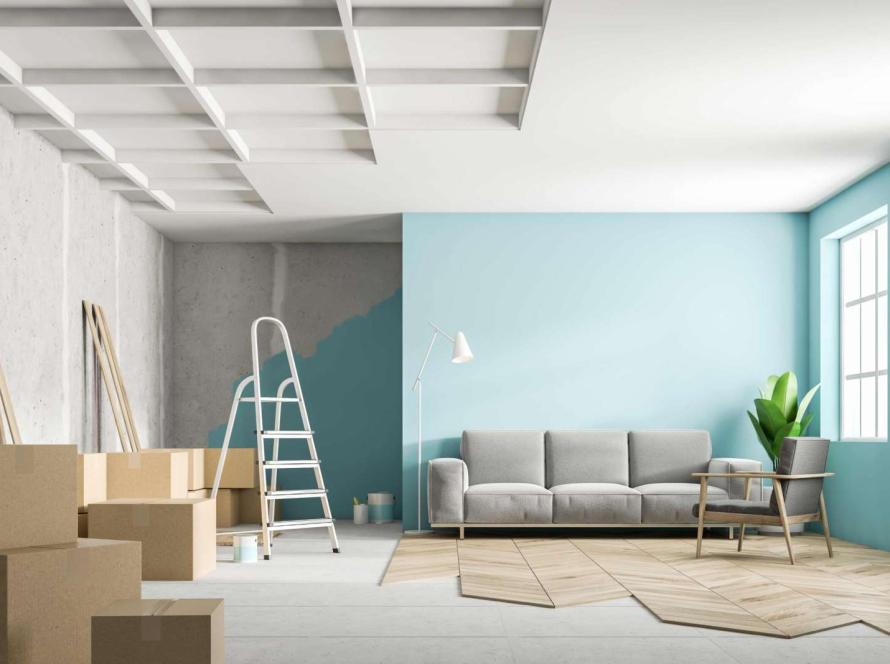Take a look around your home. Could your fixtures be described as “retro?” Has the floor seen better days? Is your kitchen less than Instagram-worthy? This could all mean it’s time to update your home. But what should win in the battle of renovation vs. remodel?
Whether you’re looking to increase the value of your home to sell it or you plan on staying and want somewhere beautiful to live, updating your home can be an exciting, stressful, rejuvenating experience.
When it comes to home updates, you have a couple of options. You could DIY some home improvements, but when you realize you aren’t the home improvement expert HGTV makes you think you are, it could be time to figure out whether you’re ready for a renovation or a remodel.
What’s the Difference Between a Renovation and a Remodel?
Home updates that go beyond switching out a light fixture or hanging some floating shelves will fall into one of two categories: renovations or remodel. While the two terms might seem interchangeable to the layman, they have distinct characteristics and purposes.
Renovations
The word “renovate” means to restore something back to its original condition. The goal is to bring it back to its former glory and rejuvenate it with a bit of life. This could include any updates to the look and feel of your home. The important thing to remember is that renovations aren’t intended to change the purpose or layout of your home.
For example, with a kitchen renovation, you would update cosmetic issues. Rather than tearing it out and completely overhauling the layout and functional space, you would simply update the look of it to something that looks and functions a bit more modern.
Remodeling
Remodeling means to alter the basic structure of a building, home, or space. That means the overall design and structural layout will likely change. With this type of project, you would be doing a more intense reworking and overhaul of your home.
For example, let’s turn to your bathroom. The tile and tub, a pale pink, scream about the era in which they were installed. The space may be tiny, so much so that you bump into your significant other while getting ready every morning. And to top it all off, you may have plumbing that’s leaking and floors that are getting soft.
A remodel of this sad bathroom would likely include cosmetic changes, like switching out the tile and the tub, but it would also include reworking the space—possibly even expanding it into an unused closet in the next room or updating the plumbing. If the floors were damaged from the leaks, it may also include a structural fix.
With these two examples, we can see that both will improve the overall aesthetic of your home, but with a remodel, you would be structurally changing your home to be safer and perhaps even changing the layout.
Renovation vs. Remodel: The Pros and Cons
As with most things in life, there are pros and cons to each approach. Which type of home improvement project you decide to take on will largely depend on how the projects will align with your goals for your home.
Renovation Pros and Cons
If your home needs a little facelift, a renovation could be for you. It’s a great way to update the look of your home, with stunning new light fixtures and the fresh coat of paint in your bedroom.

Aside from that, you’ll see plenty of other benefits, including:
- Added value to your home
- A customized look in your living space
- A fun project that you can choose to do yourself
- A cost-friendly option to update your home
A renovation ensures that you can keep the same feel of the home you love. Did your kids learn to walk down that hallway? Is your oddly-shaped dining room where you got big news about a promotion? You can maintain these features, but make them look like new again.
With that being said, there are certain cons to take into consideration:
- The costs can get out of control, depending on the cosmetic changes you do
- It could take months to complete the project
- It may be stressful
- Future buyers may not like your style
- If it’s poorly done, it won’t increase your home’s value
- You may need a permit
Also, if you have a historic home, a renovation may be your only option, thanks to historical society rules. As you’re deciding between a renovation vs. remodel, dream about the pros, but keep the cons in mind. It could make or break your decision.
Remodeling Pros and Cons
In general, remodeling is the better option if your home is poorly designed. You can completely change your house to suit your preferences. There are also a few other benefits that come along with the complete customization:
- The ability to design the home you want
- A sense of accomplishment
- More energy savings
- Increased home value
- Maximizing tax advantages
- More functional space
However, remodeling does come at a price. Keep these cons in mind:
- May not be allowed in historic homes
- Not always DIY-friendly
- Almost always requires permits
- Could be expensive
- Extensive time spent living in a construction zone
- Tax increases from rising home value
- May cost more than you expect
- May take longer than you think
Finally, it’s important to remember that you run the risk of having to pay for two homes at once. If the remodeling is extensive, you’ll likely need a place to live in the meantime. That can add to the overall cost and add some stress to the process, too.
When to Choose a Renovation vs. Remodel
With either home improvement option, there are signs that it’s time to call in a contractor.
Signs You Need a Renovation
The primary reason to choose either type of project is to modernize your home. You don’t need to keep staring at that ‘90s-era kitchen that you hate. When you choose a renovation, you can create a look that’s more aesthetically pleasing that doesn’t change the functionality of the space.
Are you noticing paint chipping in your home or on the outside? This is a telltale sign that a renovation is in order. As paint begins to chip, you’ll start noticing that it often falls apart quickly, making your home look more dilapidated than it actually is.
Fixtures are another part of your home to look at. Are they completely outdated? Chances are that they were installed when your home was first built. If you can clearly identify the decade in which they were installed, it’s time for a renovation.
Look around your home for obvious damages. Did the kids get a little too rowdy, leaving a hole in the wall? Is there a light fixture coming out of its place on the wall? These small signs of damage can be fixed quickly with a renovation.
Along with these projects, here are some examples of renovations you could do to your home:
- Repainting
- Refacing cabinets
- Replace windows
- Updating appliances
- Adding new hardware
- Replacing worn-out flooring
- Replacing dated tile
- Replace outdated mechanical systems
Any one of these projects will improve the value and feel of your home without causing too much stress. Rather than living in a mess of construction for months, renovations can usually be completed quickly and without too much impact on your day-to-day life.
Signs You Need a Remodel
The signs you need a remodel might be obvious, but oftentimes, there are problems that can slip by unnoticed. One example is a leaky roof. If you notice water stains on your ceiling, chances are that your roof is leaking and probably letting in more water than you would think. That’s a bigger problem that requires a remodel.
When you have people moving in and out of your home—kids going to college, a new baby, your parents moving in—you might suddenly realize how functional or dysfunctional your space is. If you feel like you have too much or too little space, it’s time to rework your home with a remodel.
When you walk across your floor, how sturdy does it seem? If you notice that your floor is creaking or giving way at all, it could be worth springing for a flooring remodel. There may be a foundational issue that could wind up costing far more in the long run. This can be a great time to update your flooring from carpet to hardwood or from laminate to tile, too.
Walking up to your home, does it look like the oldest house on the street? The outside of your home is like a haircut. It will date your home at first glance. If the front of your home is bringing down its curb appeal, consider a remodel to bring it up to date.
Other major home improvements like adding in a home office or turning a spare bedroom into your dream workout space is perfect for a remodeling project. Repurpose your square footage into a space that better suits your needs.
Along with these examples, check out some other remodeling projects to consider:
Rather than settling for a less-than-ideal home, a remodel can help you to take control and create the environment you’ve always wanted.
What to Expect
If you watch a home improvement show, making changes in the home seems like an easy process that takes an hour, with everything looking perfect at the end. It’s just that easy, right?
Wrong.
In reality, any type of home project takes time, a ton of work, several headaches, and more coordination than you might be anticipating. Here’s what you can expect.
The Length of a Project
Knowing how long contractors will be in and out, how long your kitchen or bathroom will be out of commission, and how long active construction will be happening is important. A renovation or remodel is likely to disrupt your day-to-day life, so you should know what you’re getting into!
With a full-home renovation or remodel, you can expect that it will take anywhere from four to eight months on average. A good rule of thumb to keep in mind is that for every $80,000 you spend, your project will take somewhere around four to six weeks.
For example, if you plan on doing renovations in a few places around your home and it’s going to cost you $100,000, it will take approximately five to about seven-and-a-half weeks. If the project will cost $160,000, it will take between eight and twelve weeks.
Of course, these are just rough averages. The length of the project will change depending on the scope. Updating a small bathroom? It probably will wind up on the lower end of the time spectrum. But if you need more extensive work, like repairing your foundation, expect it to take a bit (a lot) longer.
The Cost of a Project
Cost is definitely something that homeowners need to be aware of and take into consideration before undergoing major home repairs and improvements. With either a renovation or remodel, you can expect to spend quite a bit of money.
Renovation Costs
To start with, let’s look at renovations. These can vary widely, from simply updating the paint in a room to doing a full kitchen renovation. While it depends on the room that you are working on and the work that is being done, you can expect to spend about $60 to $150 per square foot.
As an example, say that you are renovating a 1,200 square foot home. Because you want to touch-up the entire home, you may end up spending anywhere from $18,000 to $72,000. Why does that number swing so widely?
The answer to that is in the nature of renovations: It’s cosmetic. Because it’s essentially revamping and dressing up your home, you can control some of the costs. Take drawer pulls, for instance. You could spend hundreds of dollars on a single drawer pull or you could head over to the hardware store and spend $1 per drawer pull.
The key is to be realistic about what you want to spend. Then, stick to your budget, or the costs can go through the roof. Find knockoffs where you can and you’ll get the fancy aesthetic you want at a reasonable price.
Remodeling Costs
For a remodeling project, plan on spending anywhere from $20 per square foot to $200 per square foot, depending on your home, its existing condition, and the finishes you choose.
Let’s return to our example of the 1,200 square foot home. For a full remodel, you could spend anywhere from $30,000 to $120,000. Because you’re delving into the actual structure and systems of your home, you can easily find issues that you aren’t anticipating. With issues, come costs.
For example, as you’re knocking down walls, you might realize the electrical system is completely outdated. Not only is it outdated in that room, but it’s actually outdated throughout the entire house. To bring your home up to code, you’ll have to completely replace the entire electrical system. That can cost anywhere from $1,500 to $10,000 that you may not have budgeted for.
For remodeling projects, a good practice is to have a slush fund budgeted to cover expenses like this. Otherwise, you’ll be dipping into other areas of the budget and you may not end up with the finished product you were expecting.
Tips for Surviving a Home Renovation or Remodel
While a renovation and a remodel are very different in terms of how much they cost, their purpose, and what they can do for your home, the tips for surviving them are the same. Here is your guide to surviving any type of project.
Plan Carefully
Plan, plan, and plan some more. Know exactly what you want to accomplish and what you want the end result to be. You should also plan to adjust your daily routine accordingly. These kinds of projects won’t adjust to your schedule very well.
One of the things you should plan on is to have any room that’s being worked on out of commission. Whether it’s a bedroom, a bathroom, or your kitchen, you’ll need to either make other arrangements or create makeshift temporary spaces within your home.
Choose the Right Season
Imagine tearing out your living room wall or opening up your roof during the dead of winter. The season you choose to renovate or remodel is a big deal. It can determine how comfortable you and your family are for weeks.
Along with that, timing could also affect how much you pay. In general, contractors are busiest in the summer months. This means that you’ll end up paying more for their time and labor. If you’re looking to save some money, schedule your project for the winter, if possible.
Declutter
What better time to declutter your life than when you’re remodeling or renovating your home? Not only will it rejuvenate the look of your home, but it’ll also get things out of the way of the workers.
When you decide what things to get rid of, consider holding a yard sale. You can use the profits to fund your project. You should also consider donating items that are in decent condition. This can give you a tax write-off that will be a nice treat come April.
Storage Options
If you aren’t looking to get rid of a bunch of stuff but still want to declutter your space during the time that contractors and workers are in your home, renting a storage unit isn’t a bad idea. While it might are an additional expense, it’ll allow you to get your possessions out of the way while still keeping them protected from things like dust and debris during the construction.
Babysitting and Pet Sitting
As much as you try to explain to a baby or a pet that the home is being remodeled or renovated, they will not get it. During the project, doors will be left open and curious toddlers or anxious pets will easily be able to escape. The best option is to find a sitter for your more sensitive family members.
Budget Wisely
When budgeting for a home project, it’s important to set a cap and stick to it! A budget without a hard cap is just asking to run way over cost.
It’s also important to include a slush fund. Renovations and remodeling projects notoriously have hidden issues that lead to unexpected expenses. To protect yourself, having an extra 10% that is set aside for those unexpected expenses is important.
Designate Areas
It’s easy for a project to take over your entire home. At least one room is likely to be out-of-commission, with others being used to compensate for that. A good way to maintain some order in your life is to designate specific areas of your home for certain things.
You should designate at least three primary areas areas:
- Area for work
- A place to live
- Area for staging
By having certain areas in the house, kids will know to stay clear of work zones. Plus, the contractors will have their own space in which to work without having to worry about stepping over toys or watching curious pets.
Move Distractions
The people working on your house don’t want to damage your property or do a sloppy job. But everyone gets distracted sometimes!
One of the best things you can do to maintain a distraction-free place for your contractors to work is to remove any obstacles from the work area, like food or supplies.
Instead of keeping everything in the same area where work being done, you can set up a designated area for distractions. This will give the workers a place to take a break if they need it and a place to store supplies so they don’t get lost.
Strategize for Mental Health
You should never underestimate the impact a renovation or remodel will have on your mental health. It’s a stressful process! Your entire life is going to be chaotic for at least a few weeks. What can you do?
Think about your strategy for mental health ahead of time. Have a plan in place for how you will deal with frustrations, irritations, and the constant chaos. By having these tools at your disposal, you’ll be ready for the chaos, rather than dreading it.
Pick the Right Contractor

As much as you don’t want to overpay for a contractor, you shouldn’t choose to cut costs by too much. It’s important that you don’t just go for the cheapest option!
To make sure you are getting a fair price, collect bids from several different contractors. As you compare them, notice how much the contractor’s fees are in relation to materials and labor. Before you pick the contractor, review the contract carefully ahead of time so that you can be sure that you know exactly what to expect before work starts.
Renovation vs. Remodel: Get Inspired

Compare Quotes from Top-rated Remodeling Contractors in your area.
Finally, you need to get inspired. What do you want your home to look like? What soothes you or invigorates you? Luckily, there are so many ways to find inspiration thanks to technology and the digital age. This includes things like:
- Renovator’s Blog
Ready to get started? Let us know what projects you’re looking to do and we will help you to connect with top-rated local contractors!





Facebook
Comments